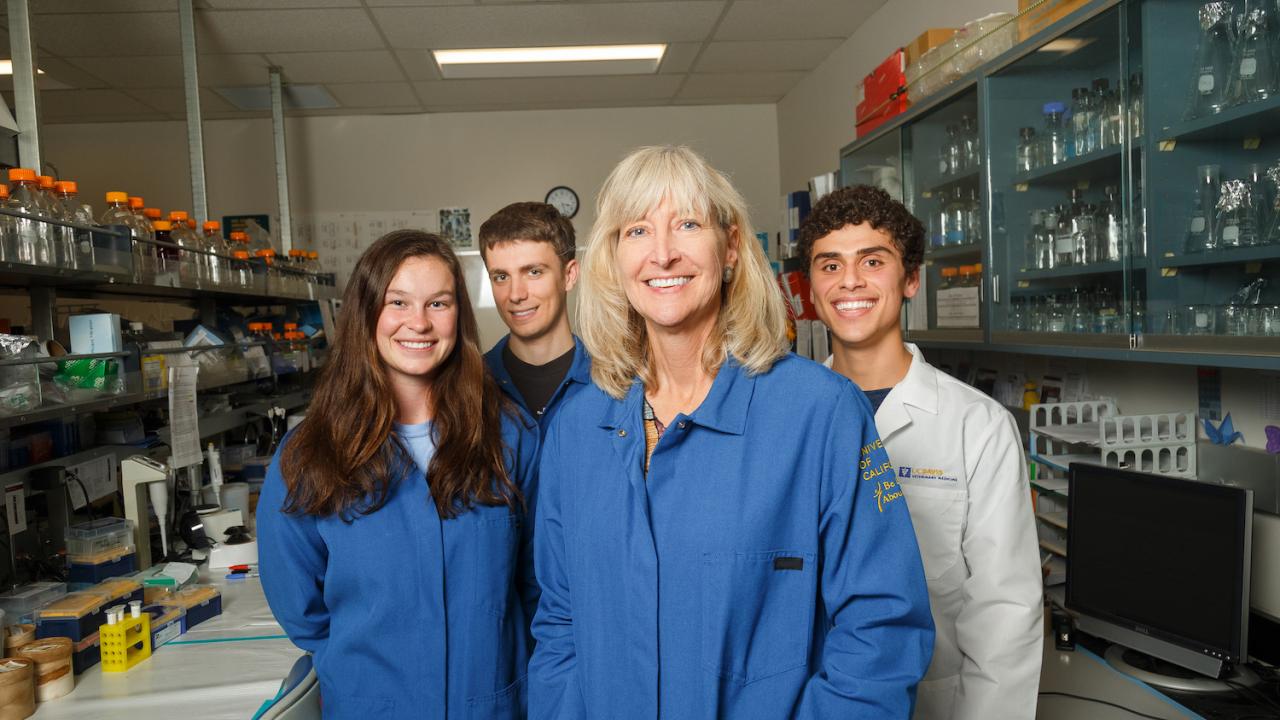
Energized
By Anita Oberbauer, Ph. D., Professor, Department of Animal Science; Associate Dean for Agricultural Sciences.
Professor Oberbauer is the recipient of the 2018-19 UC Davis Prize for Undergraduate Teaching and Scholarly Achievement.
The excitement of learning endures
On a recent faculty field trip, a newly hired professor asked me how I stay motivated to teach the same class over many years. Reflecting on the practices I use to keep the material from getting stale and maintain excitement in sharing the information, I realized it is that excitement in sharing that spurs me on to ferret out new information and ways to convey it.
Perhaps that excitement comes from being a first generation college student. Being exposed to vast amounts of information on diverse topics for the first time was a thrill. I felt like a sponge sopping up anything and everything.
Feeling like I had to prove myself worthy of being in college added pressure to master these new areas.
Although I was a science major, learning about legal processes from a county judge, or methods to deconstruct fairy tales, or the historical impact of the fall of the Medici family from Professor F. Roy Willis (who clearly made an impact as I still recall his name decades after taking his course as a first-year student) made lasting impressions on how to present information in a way that facilitates student learning.
Bringing course content to life
The things that have stuck with me over all these years are the elements that bring a topic alive. By adding flourish to the basic information, these small details create a finished concept that stays with a student. For example, in Willis’s western civilization course, I remember a discussion of the wine served that brought to life the historical intrigue of the Medicis. In my own class, I pepper the lectures with “fun facts” to illustrate concepts. To emphasize the tapetum lucidum found in nocturnal animals, I describe how students can look for different colors of “eye-shine” in different species if they go out at night with a flashlight. As another example, I use the story of how a lumberjack made a career out of rescuing cats from trees to illustrate that cats have little lateral mobility of their wrist joints and the righting reflex.
Even though I teach a very large-lecture general biology class, I want that class to speak at a personal level to each student, so I strive to find details that will make the science exciting and relevant to every student from across the campus: for the engineering students the mechanics of bird flight; for the sociology student, the impact of pets on communities.
An indicator of success is that students from years and years ago still send me news clippings, photographs, or emails with links to things they think I would be interested in or relate to the class they took with me. Incorporating these keeps the material fresh for me and creates a connection between past and present students
First and foremost a student for life
I truly believe that a successful teacher must be first and foremost a student for life. If, as an instructor, you are not learning you may as well hang it up.
Maybe the curiosity was an outgrowth of my being first-gen; regardless, it is imperative to find the elements of the topic that excite you and make you want to explore that topic more deeply. I troll the literature and the news for the latest and greatest related to the course topics, and I use socially relevant material for the writing assignments which keeps things fresh—for example, the recent controversies surrounding genuine and faux service animals.
I am privileged to be in a department that values and promotes teaching excellence and as colleagues we often discuss effective teaching strategies, including those that don’t seem to resonate with students. We share things we come across that we think will be of interest to each other’s students thereby creating a departmental culture of excitement and interest. And I’m grateful for my young colleague’s question, and the resulting reflection.
Connecting with students is key
In the classroom environment I strive to present an image of accessibility. I stay after class to answer questions or listen as students share their keenness for the topic. I invite students to my office hours, where our conversations are wide ranging—from lecture topics to study skills, how to approach professors – even roommates and housing. For students unable to make office hours, I set up appointments or am available for email consultations. College life can be so overwhelming, especially for first-gen students, that having a sympathetic ear with specific advice makes the transition easier and promotes broader student success.
I also make it a point to discuss boundaries with new faculty. Specifically, we are faculty and students are students and those roles need to be maintained for the success of both.
Many students join my lab as interns as an outgrowth of office hour and classroom interactions. This link between my research and teaching efforts enriches both and further ignites my enthusiasm for the material. Interacting in a more informal way gives insight into how today’s students approach learning. Listening to them speak to their peers about classes and what works or doesn’t work for them allows me to evolve my approach to instruction so it can be as effective as possible.
Incorporating students into my research is win-win! Better research, sustained enthusiasm, and improved teaching methodologies.
Request a Reflective Teaching Journal
As you think about ways to reflect on your teaching, let CEE support your reflection with a free journal. If you would like a reflective journal, complete the following form and we will send you one via campus mail.
